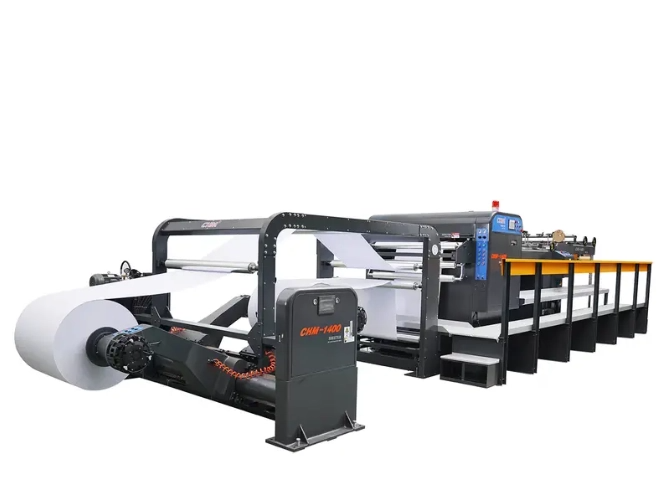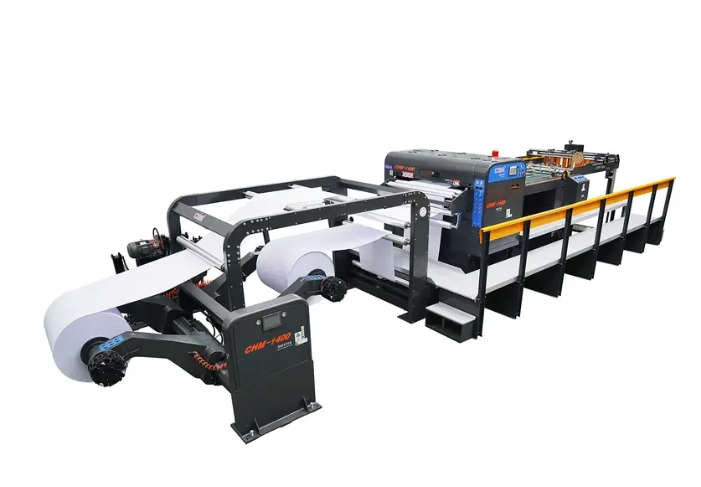 English
English- All
- Product Name
- Product Keyword
- Product Model
- Product Summary
- Product Description
- Multi Field Search
 English
English

Views: 181 Author: Site Editor Publish Time: 2025-08-26 Origin: Site











In the world of printing, packaging, and paper processing, efficiency and versatility are key factors in choosing the right equipment. Among the most critical machines in these industries is the paper sheeting machine, a device designed to convert large paper rolls into precise, flat sheets. One of the most common questions asked by industry professionals is: "Can a paper sheeting machine cut both thin and thick materials?"
The short answer is yes—modern paper sheeting machines are engineered to handle a wide range of material thicknesses. However, the answer involves more than just a simple yes or no; it requires an understanding of the technology behind these machines, the mechanics of cutting, and the adjustments necessary for different materials. In this article, we’ll explore in detail how paper sheeting machines achieve this flexibility, the factors that affect performance, and what businesses should consider when working with varying material types.
A paper sheeting machine is designed to take continuous rolls of paper or similar materials and cut them into sheets of specified dimensions. It’s used extensively in printing houses, packaging manufacturers, stationery producers, and more. The core of its function revolves around precision cutting, high-speed operation, and consistent sheet quality.
Modern sheeting machines are not limited to just paper. Depending on their configuration and blade type, they can cut materials such as thin film, cardstock, coated paper, laminated sheets, and even light cardboard. The ability to work with both thin and thick materials is a direct result of engineering advancements in machine design, adjustable cutting pressure, and advanced control systems.
For thin materials such as delicate paper stock, the machine needs a fine-tuned cutting mechanism to prevent tearing or curling. For thicker materials like coated board or heavy card, the blade must deliver more force while maintaining accuracy. This adaptability is the reason why paper sheeting machines are favored by industries with diverse production needs.

When working with thin materials, precision and gentle handling are crucial. Thin substrates are prone to issues such as tearing, edge fraying, or curling if not handled correctly. A high-quality paper sheeting machine addresses these challenges through:
Sharp, Fine-Edge Blades: Ensuring clean cuts without crushing fibers.
Adjustable Cutting Speed: Slower speeds for thin stock to prevent vibration and material shifting.
Vacuum or Air-Suction Feeding Systems: Stabilizing lightweight sheets during the cutting process.
Anti-Curl Mechanisms: Minimizing deformation caused by cutting tension.
Thin materials typically range from 40gsm lightweight paper to 120gsm fine stock. In industries such as high-end printing, packaging for luxury goods, and specialty paper production, accuracy at this level is essential to maintaining product quality. A well-calibrated sheeting machine can consistently cut thin materials without compromising speed or output efficiency.
Cutting thicker materials, such as cardstock, coated board, or laminated sheets, presents different challenges. These materials require more cutting force, stability, and precise blade alignment to avoid chipping or uneven edges.
A professional-grade paper sheeting machine manages thick materials by integrating:
High-Torque Cutting Motors: Providing sufficient force for dense substrates.
Heavy-Duty Rotary or Guillotine Blades: Designed to maintain sharpness and withstand cutting resistance.
Robust Material Feeding Systems: Ensuring smooth transport without jamming.
Precision Pressure Control: Adjusting the blade pressure for different thicknesses.
Thicker materials can range from 200gsm card to over 400gsm coated board. Industries such as packaging manufacturing, hardcover book production, and specialty printing rely heavily on the machine’s ability to handle these substrates with the same precision applied to thinner materials.
| Feature / Parameter | Thin Materials (40–120gsm) | Thick Materials (200–400+gsm) |
|---|---|---|
| Cutting Blade Type | Fine-edge, high sharpness | Heavy-duty rotary/guillotine |
| Cutting Speed | Slower to prevent tearing | Moderate to maintain accuracy |
| Feeding Mechanism | Vacuum or air-suction feed | Heavy-duty mechanical feed |
| Pressure Adjustment | Low, fine-tuned | Higher, controlled force |
| Common Applications | Printing, stationery, packaging for light products | Packaging, hardcover books, display boards |
This table highlights the differences in operational adjustments needed for handling varying thicknesses. A well-designed paper sheeting machine will have flexible settings to seamlessly transition between these two modes.
While a paper sheeting machine can technically cut both thin and thick materials, performance depends on several factors:
Blade Quality and Maintenance – Dull blades will compromise cut quality for both thin and thick materials.
Machine Calibration – Properly adjusting pressure, speed, and feeding mechanisms is essential.
Material Composition – Coated papers and laminated sheets may require specialized blades or slower cutting speeds.
Operator Skill – Experienced operators can fine-tune machine settings to optimize output.
Environmental Conditions – Humidity and temperature can affect paper behavior during cutting.
Failure to consider these factors may result in poor cutting accuracy, material waste, and reduced machine lifespan.

Investing in a sheeting machine that can cut both thin and thick materials offers several advantages:
Cost Efficiency: Eliminates the need for multiple specialized machines.
Space Saving: Reduces floor space requirements in production facilities.
Production Flexibility: Enables manufacturers to accept a broader range of orders.
Consistent Quality: Ensures uniform results across different material types.
Scalability: Supports growth in production without major equipment changes.
For businesses dealing with diverse customer needs, versatility in material handling directly translates into higher profitability and market competitiveness.
Q1: Can a paper sheeting machine cut materials other than paper?
Yes. Depending on the blade type and machine configuration, it can cut thin films, coated boards, laminated sheets, and light cardboard.
Q2: How often should blades be replaced or sharpened?
This depends on usage frequency and material type. For high-volume production, blades should be inspected weekly and sharpened or replaced when cuts show signs of fraying.
Q3: Does cutting thick materials reduce machine lifespan?
Not if the machine is designed for it. High-quality sheeting machines have robust components to handle thick stock without excessive wear.
Q4: What is the maximum thickness a paper sheeting machine can cut?
This varies by model, but professional machines can typically handle up to 400gsm or more with the right adjustments.
Q5: How do I prevent curling in thin paper after cutting?
Use machines with anti-curl systems and ensure humidity control in your production environment.
A well-engineered paper sheeting machine is more than capable of cutting both thin and thick materials, provided it is used correctly and maintained properly. Its adaptability lies in the combination of high-precision engineering, adjustable cutting parameters, and quality blade systems.
For businesses that require the flexibility to process a variety of substrates—from lightweight paper to dense coated boards—investing in a versatile sheeting machine is a smart move. It not only maximizes production efficiency but also ensures consistent, professional-quality results across different product types.